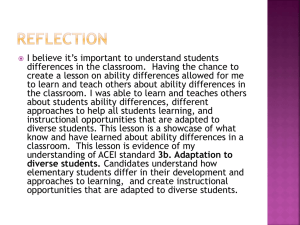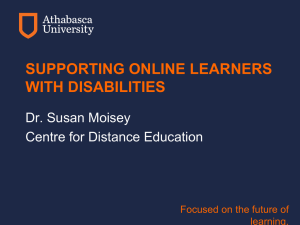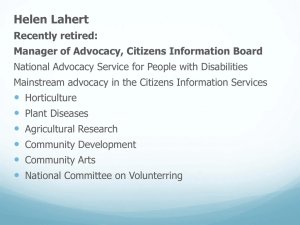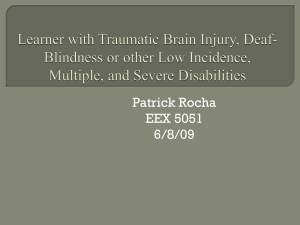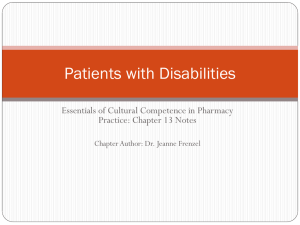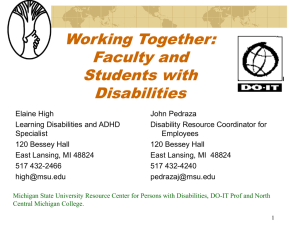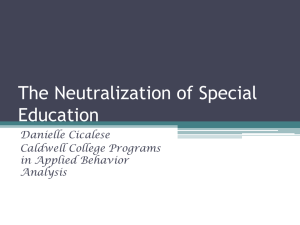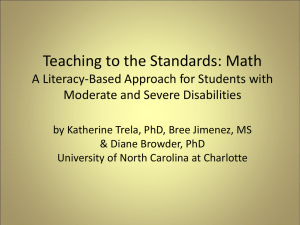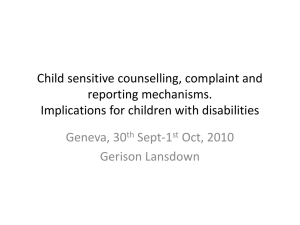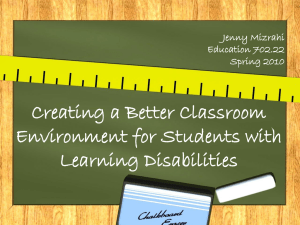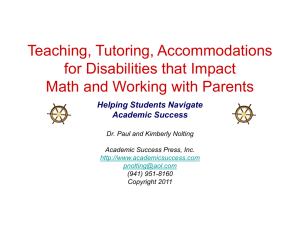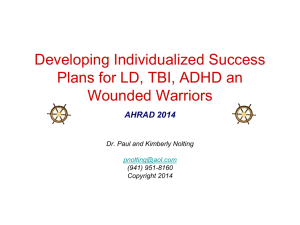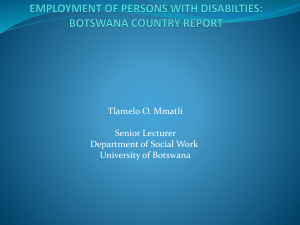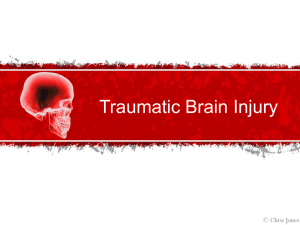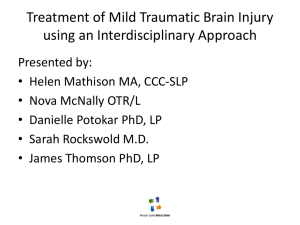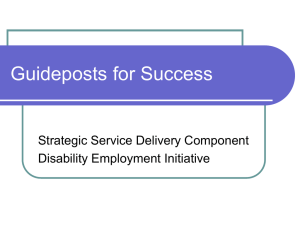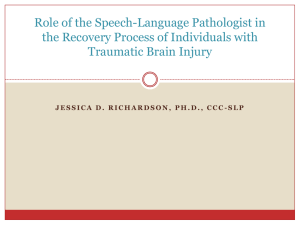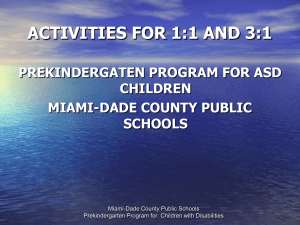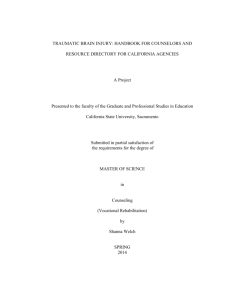Traumatic Brain Injury (TBI)
advertisement
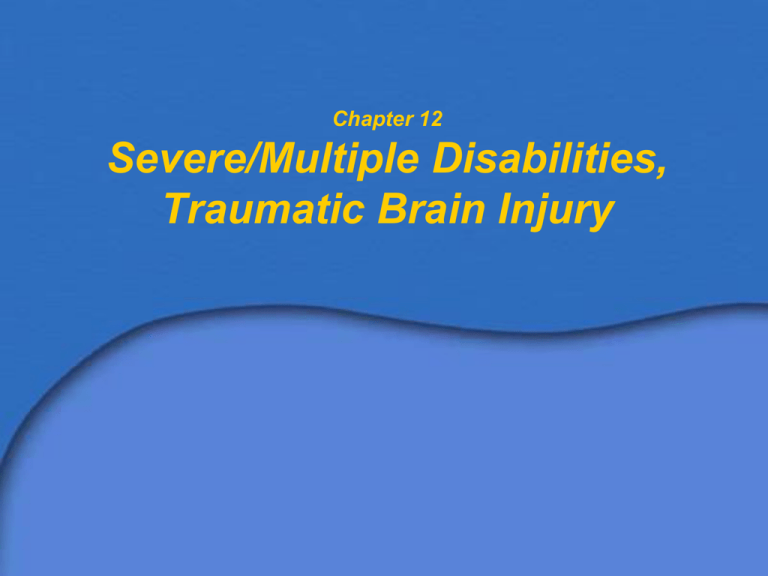
Chapter 12 Severe/Multiple Disabilities, Traumatic Brain Injury Low Incidence Disabilities • Low Incidence disability – Disabilities that do not occur very often. Together Multiple Disabilities, TBI, and deaf-blindness represent less than 3% of all children who receive special education. • Many of these individuals cannot perform the most basic, everyday tasks such as: – Eating – Toileting – Communicating basic needs Severe and Multiple Disabilities Severe disability • Significant disabilities in intellectual, physical, and/or social functioning • No single definition (perceptions of what is severe may vary and are based on a multitude of intellectual assessments Multiple disabilities • Multiple disabilities means concomitant impairments, that causes such severe educational problems that they cannot be accommodated in special education programs solely for one impairment Characteristics and Prevalence • Characteristics – Slow acquisition rates for learning new skills – Poor generalization and maintenance of newly learned skills – Limited communication skills – Impaired physical and motor development – Deficits in self-help skills – Stereotypic and challenging behavior • Prevalence – Estimates range from 0.1% to 1% of the population Causes • In almost every case of severe disabilities, a brain disorder is involved – Chromosomal disorders – Genetic or metabolic disorders that can cause serious problems in physical or intellectual development • Complications in pregnancy – prematurity, Rh incompatibility, infectious diseases, alcohol/drug intake • Severe disabilities may develop later in life from head trauma • In about one-sixth of all cases, the cause cannot be clearly determined Syndromes that may result in severe disabilities • Hurler Syndrome (lack of an enzyme) – severe MR, physical disabilities, early death • Lesch-Nyan Syndrome (genetic) – SIB, aggression, neurological problems, MR • Rett Syndrom (genetic) – Regression to 6-18 months, loss of speech, motor and social functions, MR • Cornelia de Lange Syndrome (chromosomal) – Physical disabilities, health impairing conditions, Severe MR, SIB • Angelman Syndrome (chromosomal) – Speech and language deficits, balance and gait, seizures, microcephaly, severe MR Traumatic Brain Injury (TBI) Definition • an acquired injury to the brain Resulting in total or partial functional disability Adversely affects a child’s educational performance • TBI is the most common acquired disability in childhood • 1 in 500 school-age children will be hospitalized with TBI • Leading cause of death in children (1/3 of all accidental deaths in children) Traumatic Brain Injury (TBI) • Open Head Injury – Penetration of the skull – bullet or forceful blow to the head caused by a sharp object – Usually result in specific deficits sensory or motor functions • Closed Head Injury – Head hits a stationary object with such force that the brain slams inside the cranium. Stress pulls apart and tears nerve fibers or axons – – – – Car accidents Shaken baby syndrome Severity depends on the part of the brain that was injured Mild injury (contusions) - recovery Traumatic Brain Injury (TBI) • Temporary or lasting impairments – Physical and sensory changes • Lack of coordination, spasticity of muscles – Cognitive impairments • Short and long term memory deficits, difficulty maintaining attention and concentration – Social and behavioral problems • Mood swings, lack of motivation What Should Be Taught? 1. 2. 3. 4. 5. Functional skills - activities of daily living skills (ADLs) Age-appropriate skills Making choices skills Communication skills (PECS /AAC) Recreation and leisure skills Instructional Methods: How Should Students Be Taught? • Instruction must be carefully planned, systematically executed, continuously monitored – The student’s current level of performance must be assessed – The skill to be taught must be defined clearly – The skill may need to be broken down into smaller component steps – The teacher must provide a clear prompt to cue the child – The student must receive feedback and reinforcement – Strategies that promote generalization and maintenance must be used – The student’s performance must be directly and frequently assessed Partial Participation, Positive Behavioral Support, and Small Group Instruction • Partial participation – Students can be taught to perform selected components or an adapted version of the task • Positive behavioral support – Use of functional assessment methodologies to support student’s placement • Advantages of small group instruction – Skills learned in small groups may be more likely to generalize – Provides opportunities for social interaction – Provides opportunities for incidental or observation learning from other students – May be a more cost-effective use of teacher’s time The Challenge and Rewards of Teaching Students with Severe and Multiple Disabilities • Must be sensitive to small changes in behavior • The effective teacher is consistent and persistent in evaluating and changing instruction to improve learning and behavior • Working with students who require instruction at its very best can be highly rewarding Fyffe et al • Participant – Matt, 9 year old boy with TBI • Target Behavior – touching or attempting to touch others in the area of the groin, buttocks or breasts. • Functional Analysis – 20 min sessions 1) Demand, 2) attention, 3) play. – Results suggested attention function • Treatment – FCT + EXT - use of graduated guidance to hand the experimenter an attention card. • Results?

